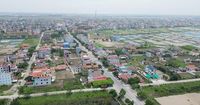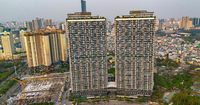In March 2025, the real estate market in Vietnam witnessed a significant surge in demand, particularly for land plots in regions previously overlooked by investors. Areas such as Ninh Binh, Phu Tho, Quang Nam, Bac Giang, and Thai Binh have become hotspots for buyers, as revealed in the Q1/2025 real estate market overview by Batdongsan.com.vn.
The report noted that while the rental market remained relatively stable, the demand for properties for sale in Hanoi and other provinces was quite active in the early weeks of March. Compared to February 2025, the search demand in Hanoi increased by 27%, while in other provinces, it skyrocketed by 75%. In Ho Chi Minh City, the increase was a more modest 20%.
Among various property segments, land plots exhibited the strongest growth in both interest and posting volume. In March 2025, searches for land plots surged by 50% compared to the previous month. Other segments such as townhouses, private houses, and apartments saw more modest increases of 32%, 26%, and 15%, respectively. The volume of postings for land plots also rose by 34%, trailing only behind private houses, which increased by 37%.
According to a survey of brokers conducted by Batdongsan.com.vn for the first quarter of 2025, 44% of participants reported that transactions for land plots remained stable compared to the first quarter of 2024, while 24% noted an increase in activity. This trend indicates a robust interest in land plots, particularly in the Northern provinces.
In March 2025, the search volume for land plots in Hanoi jumped by 52%, while Ho Chi Minh City saw a 31% increase. In other provinces, the growth was even more pronounced at 54%. The average asking price for land plots also rose significantly during this period. In Hanoi, prices increased by 42%, in Ho Chi Minh City by 7%, and in other provinces by a staggering 67% compared to January 2023.
Mr. Dinh Minh Tuan, Southern Regional Director of Batdongsan.com.vn, highlighted that consumers in Hanoi are increasingly interested in suburban land plots, whereas those in Ho Chi Minh City prefer plots closer to the city center. Notably, land plots in Northern provinces saw remarkable price increases, with Hung Yen witnessing a 55% rise, Bac Ninh 46%, and Hanoi 42% compared to the first quarter of 2023.
In contrast, the Southern provinces experienced more moderate price fluctuations, with Dong Nai increasing by 30%, Binh Duong by 25%, and Ho Chi Minh City by only 5%. Mr. Tuan noted that the North-South price differentiation trend continues, with the Northern region displaying wider and higher price distributions than the South.
In the Central region, Quang Nam's land plots attracted increased interest, especially in coastal areas adjacent to Da Nang. The selling prices of land in Da Nang also saw significant growth, with Cam Le district up by 80%, Lien Chieu by 75%, and Hoa Vang by 50% compared to January 2023.
As the conversation around province mergers heats up, the Northern provinces are particularly responsive to these developments. Data compiled from Google in February 2025 indicated that the Northern region, including Hanoi, recorded the highest search volume for the keyword "province merger." Provinces such as Binh Duong and Vinh Phuc followed closely behind.
Despite the optimism surrounding the real estate market, experts caution against impulsive investments. Mr. Nguyen Quoc Anh, Deputy General Director of Batdongsan.com.vn, emphasized the importance of thorough analysis when considering opportunities arising from province mergers. He advised investors to evaluate economic, cultural, and infrastructural factors to ensure sustainable growth in property values.
Investors should also be wary of the potential for price corrections, especially in areas experiencing rapid growth driven by speculative interest. The Vietnam Association of Real Estate Brokers (VARS) has warned that property values need a solid foundation of infrastructure and economic development to sustain long-term growth.
In the case of Hanoi and Ha Tay, for example, property prices in the old Ha Tay area surged between 2.6 to 15 times from 2016 to 2025, whereas prices in old Hanoi increased by an average of 2.4 times. However, many projects in the old Ha Tay region faced delays or abandonment, raising concerns about the sustainability of such price increases.
As the real estate market continues to evolve, the potential for significant returns exists, but it comes with inherent risks. Investors are encouraged to adopt a cautious approach, focusing on data-driven analysis rather than succumbing to herd mentality or speculative bubbles.
In summary, the first quarter of 2025 has shown promising signs of recovery in Vietnam's real estate market, particularly in the land plot segment. However, the uneven recovery across different regions and property types reflects a broader trend of differentiation that investors must navigate carefully.




